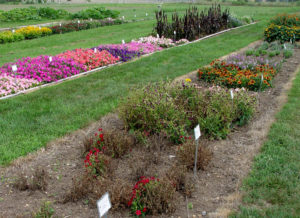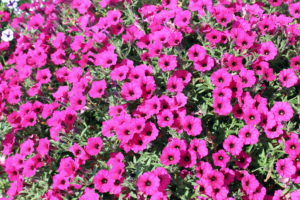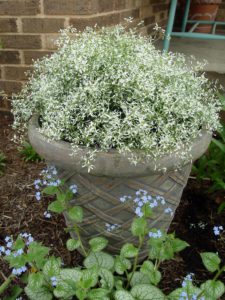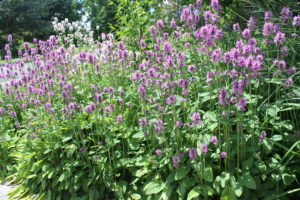Are New Varieties Really Better?
April 2nd, 2019
Every new growing season brings a boatload of new plant introductions, most of them trumpeting some sort of improvement or new twist, if not one-of-a-kind break-throughs.
They can’t all be better, can they?
The short answer is no. Many are more of the same, and some aren’t even as good as what’s already on the market.
However, when you look at the whole of what we can pick from now vs. 20 or 30 years ago, we’re light years ahead.
Plant breeders and seed companies have done an amazing job at bringing us new choices that bloom better, bloom longer, fight off disease, and grow in more compact, easier-to-care-for habits.
I spend a lot of time evaluating and writing about new varieties because I believe that picking superior plants and getting them in the right spot is one of the two keys to gardening success – good soil being the other. (Living well away from deer is a third!)
One of the comments to my new-plant series this year made me wonder, though, whether gardeners are taking advantage of the good stuff.
“Differences over what’s currently on the market is minuscule,” reader Owen said about my PennLive post on new annual flowers. “Every company just wants to expand every line they have and put out new cultivars to maximize plant royalties.”
There’s some truth in that cynicism, mainly when it comes to differences in annuals from one company’s line to another.
Multiple companies produce a full range of annuals… everything from alyssum to zinnia and often in a rainbow of colors in each species.
The genetics have become so good nearly across the board that you won’t find big differences, for example, between Proven Winners’ line of lantanas and Ball Floraplant’s.
Visit Penn State’s Trial Gardens in Lancaster County (it’s free and open to the public), and you’ll see how most of the new and coming varieties are performing very, very well.
Yeah, companies want you to buy as many of their varieties as possible, but for gardeners, having a healthy stockyard of choice is a good thing. The competition also prods breeders to keep tweaking performance and looking for any niche to set them apart.
What gardeners may not realize is that these varieties are the cream of the crop. They’re generally the annuals that end up selling for $2.99 or $3.99 each in four-inch pots, not in 99-cent four-packs at the grocery store.
The difference between the cheapie four-pack petunias and the $3.99 Supertunias is huge, in my experience.
The cheap stuff is usually older, seed-grown varieties that have genetic weakness that breeders of the good stuff “fixed” by crossing and selecting years ago – things like so-so flower power, susceptibility to drought or root rot, rangy growth habits, and a good chance of dying in the heat of summer.
I don’t like paying $3.99 instead of 99 cents any more than most gardeners do, but when it comes to annuals, most of the time you get what you pay for. I’ve decided that I’d rather pay more for fewer plants that look great all season than invest in flats that are mostly dead by mid-summer.
You can’t always go strictly by price. Higher price doesn’t always mean superior performance.
That’s why trial gardens like Penn State exist – to help growers and gardeners sort out the superb from the good and the good from the lousy.
We also have to lean on garden centers in the hopes that their buyers have done enough homework to decide which varieties to carry. The best ones cull through the confusion to select (hopefully) the top performers.
Chain stores tend to carry the same “bread-and-butter” basic lineup year in and year out, focusing on the most familiar and most sellable varieties that aren’t usually the best the industry has to offer. There, you’re trading price for performance and the consolation that if your purchase croaks, they’ll usually just give you another one.
First-hand experience and sharing results from gardener to gardener are other good ways to zero in on the top performers.
My lists of favorite varieties (and “Bottom 10” varieties) also might help. These lists are free and posted on my George’s Handy Lists page.
The other thing plant companies have done in the last 20/30 years is give us entirely new species.
When I first started planting annuals 30+ years ago, there were no angelonias, calibrachoa, or white euphorbias. These are now some of our best annuals for pots, baskets, and beds.
Breeders also have given us gobs of big, beautiful coleus that thrive in both sun and shade, geranium hybrids that are way better than Grandma’s basic red ones (especially check out the Calliope series), impatiens hybrids that sidestepped the downy-mildew disease disaster, and wonderful new pot centerpieces like digiplexis, dark-leaved hibiscus, and dwarf papyrus.
And that’s just in annuals.
Perennial breeders also have been hard at work, giving us new colors, more compact, and longer-blooming versions of old favorites as well as altogether new options.
A few of those that come to mind are the spiky lavender ‘Hummelo’ betony that won both a PHS Gold Medal and Perennial Plant of the Year honors this year, the many intricately leaf-colored varieties of foamybells (a cross between coralbells and foamflowers), and a super-showy new peony hybrid called ‘Bartzella.’
Even more impressive advances have happened in flowering shrubs. When I look at what I can grow now vs. just a couple of decades ago, there’s no comparison.
I wonder how I got along and managed to have any success with what now seems like a very limited selection of mostly so-so performers.
Back then, we didn’t have such bullet-proof beauties as pink-blooming panicle hydrangeas (i.e. Pinky Winky and Quick Fire), we didn’t have the elegant, black-leafed Black Lace elderberry or the gold-leafed Mellow Yellow spirea, and we didn’t have dwarf or dark-leafed ninebarks.
Even the wildly popular Knock Out rose wasn’t on the market yet, and we had no sterile varieties of butterfly bush and barberry to head off invasiveness issues.
Granted, we’re paying more for our plants these days, and it can seem a lot more confusing to go into a garden center and encounter an overwhelming amount of choices with fewer employees to help us pick.
But I’ll take that any day over inferior plants… and fewer of them.












